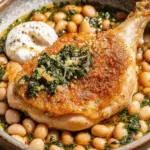Gordon Ramsay’s scrambled eggs are not your average morning meal. They transform a simple breakfast staple into a velvety, luxurious dish using a unique cooking technique that completely redefines how scrambled eggs are prepared. Unlike traditional methods where eggs are whisked beforehand and cooked quickly over high heat, this approach embraces slow, gentle cooking with constant movement. Using a saucepan instead of a frying pan, cold butter to control heat, and finishing with crème fraîche to halt cooking and add richness, this method creates eggs that are incredibly creamy, soft, and indulgent. This recipe is perfect for busy college mornings when you want something quick yet special, or for weekend brunches when you have a little more time to savor the process.
Full Recipe:
Ingredients
-
Cold eggs
-
Cold unsalted butter, cubed
-
Crème fraîche or sour cream
-
Salt, to season after cooking
-
Ground black pepper, to season after cooking
-
Fresh chives, chopped for garnish (optional)
Directions
-
Place cold eggs directly into a cold nonstick saucepan without whisking
-
Add cubed cold butter to the eggs in the pan
-
Set the pan over medium-low or medium heat
-
Stir constantly with a spatula, scraping the bottom and sides of the pan
-
As the eggs begin to thicken, remove the pan from heat and stir for 10–15 seconds
-
Return to heat and repeat the on-off process for 3–4 minutes until eggs are barely set and still moist
-
Remove from heat and stir in crème fraîche to stop cooking
-
Season with salt and pepper to taste
-
Garnish with chopped chives if desired
-
Serve immediately
Nutrients
-
Calories: ~317 kcal per serving
-
Protein: 17g
-
Fat: 27g
-
Carbohydrates: 2g
-
Cholesterol: 375mg
-
Fiber: 0g
-
Sodium: 320mg
Why This Recipe Stands Out
The brilliance of Gordon Ramsay’s scrambled eggs lies in the precision and thoughtfulness behind the cooking technique. The use of cold butter and eggs slows the cooking temperature, allowing a creamy, custard-like texture that is difficult to achieve with the standard high-heat scramble. The repeated process of removing the pan from heat and stirring harnesses residual warmth to finish cooking gently, preventing the common mistake of rubbery, dry eggs.
The addition of crème fraîche is a clever finishing touch; it doesn’t just enrich flavor but halts the cooking instantly, so the eggs stay perfectly soft and moist. The timing and technique result in a scrambled egg experience that is rich and indulgent, yet delicate and refined. This recipe demonstrates how attention to heat control and ingredient quality can transform a simple dish into a gourmet breakfast. It’s especially useful for those who often find scrambled eggs too dry or overcooked, offering a reliable method to get the perfect result every time.
The Benefits of the Ingredients
Eggs are nutrient powerhouses, rich in complete protein, essential vitamins like B12, D, and riboflavin, and minerals such as selenium and choline, which are important for brain function and metabolism. Using fresh, cold eggs maximizes flavor and texture in this preparation. Unsalted butter adds creaminess and healthy fats that improve nutrient absorption and contribute to the luscious mouthfeel. Crème fraîche, while rich, offers beneficial probiotics if made traditionally, supporting gut health alongside adding tangy flavor.
The timing of seasoning—adding salt only after cooking—is crucial to maintain moisture. Salt added too early can draw water out of the eggs, resulting in a watery scramble. Fresh chives add not only color and a mild, fresh onion flavor but also antioxidants, vitamins A and C, and compounds that support digestion and immunity. This recipe balances indulgence with nutrition, delivering energy and satisfaction to power your day.
Cooking Tips
The secret to perfect scrambled eggs here is patience and constant stirring. Never whisk or salt the eggs before cooking; whisking can introduce air and break down the proteins too early, leading to a less creamy texture. Using a saucepan rather than a frying pan is important because the higher sides help keep heat more controlled and encourage the slow cooking process.
Keep your spatula moving steadily, scraping every part of the pan to prevent the eggs from sticking or forming large curds. The on-off heat method allows the eggs to cook gently and evenly — removing the pan from the heat stops cooking while stirring helps dissipate heat and encourages even coagulation. Use quality butter and fresh eggs for best results, and don’t rush the process; the eggs are worth the wait.
If crème fraîche isn’t available, sour cream or even Greek yogurt can work as substitutes to stop the cooking and add richness, though the flavor profile will vary slightly. Serve the eggs immediately, as they will continue to cook from residual heat if left standing, and their soft texture is best enjoyed fresh.
Serving Suggestions
Gordon Ramsay’s scrambled eggs are incredibly versatile and pair wonderfully with many breakfast or brunch accompaniments. Serve them simply on warm, buttered sourdough or brioche toast for a classic, comforting experience. For added indulgence, top with smoked salmon, roasted cherry tomatoes, or sautéed wild mushrooms, which provide texture and umami contrast.
For a heartier meal, pair the eggs with avocado toast sprinkled with chili flakes, a side of crispy hash browns, or grilled asparagus. They’re also excellent tucked inside a breakfast sandwich with bacon or sausage for on-the-go mornings. For brunch gatherings, present them alongside fresh fruit, a crisp salad, or artisanal cheeses. Garnish with microgreens or a drizzle of truffle oil to elevate the dish further for special occasions.
Conclusion
Gordon Ramsay’s scrambled eggs prove that simple ingredients, combined with mindful technique, can elevate a humble dish to restaurant-quality excellence. By using cold eggs and butter, slow heat, and constant stirring, you achieve an unmatched creamy, velvety texture that sets this recipe apart from traditional scrambled eggs. The addition of crème fraîche not only enriches but perfectly halts cooking, ensuring a moist finish every time.
This recipe is perfect for college students and busy professionals looking for quick yet indulgent back-to-school breakfasts or for anyone who appreciates the art of breakfast cooking. Whether you’re enjoying them as a weekday staple or a special weekend treat, these scrambled eggs offer a delicious start to any day. Mastering this technique means you’ll always have a foolproof way to impress yourself and others with a simple, satisfying meal that feels truly special.






